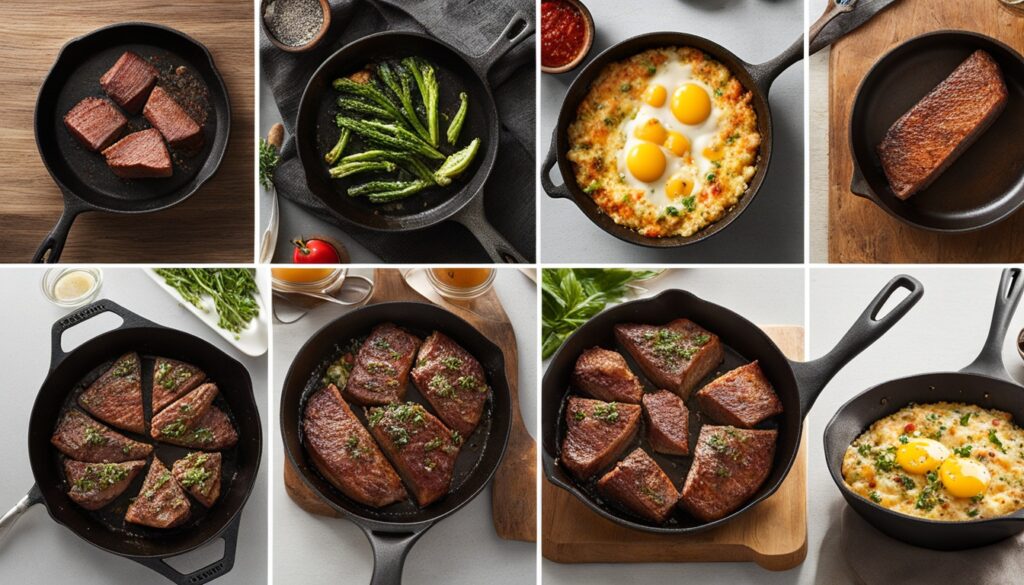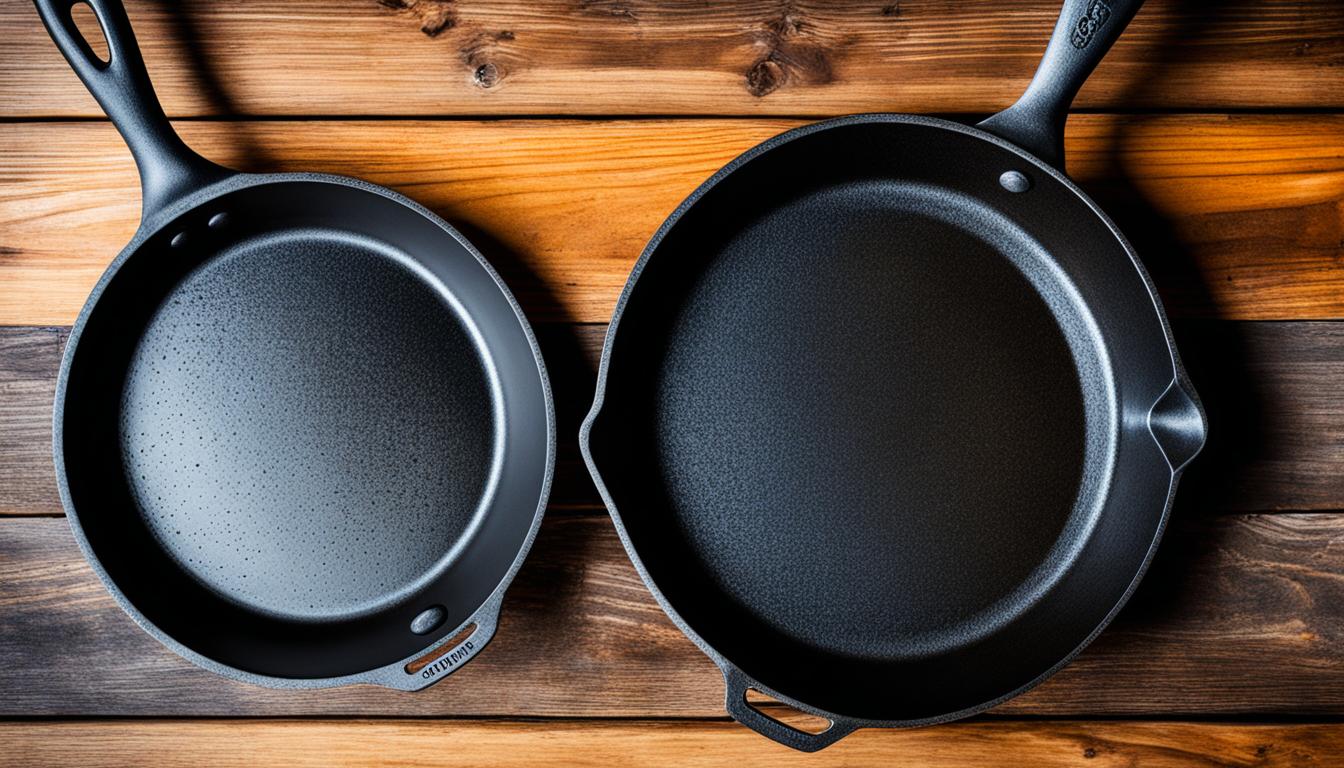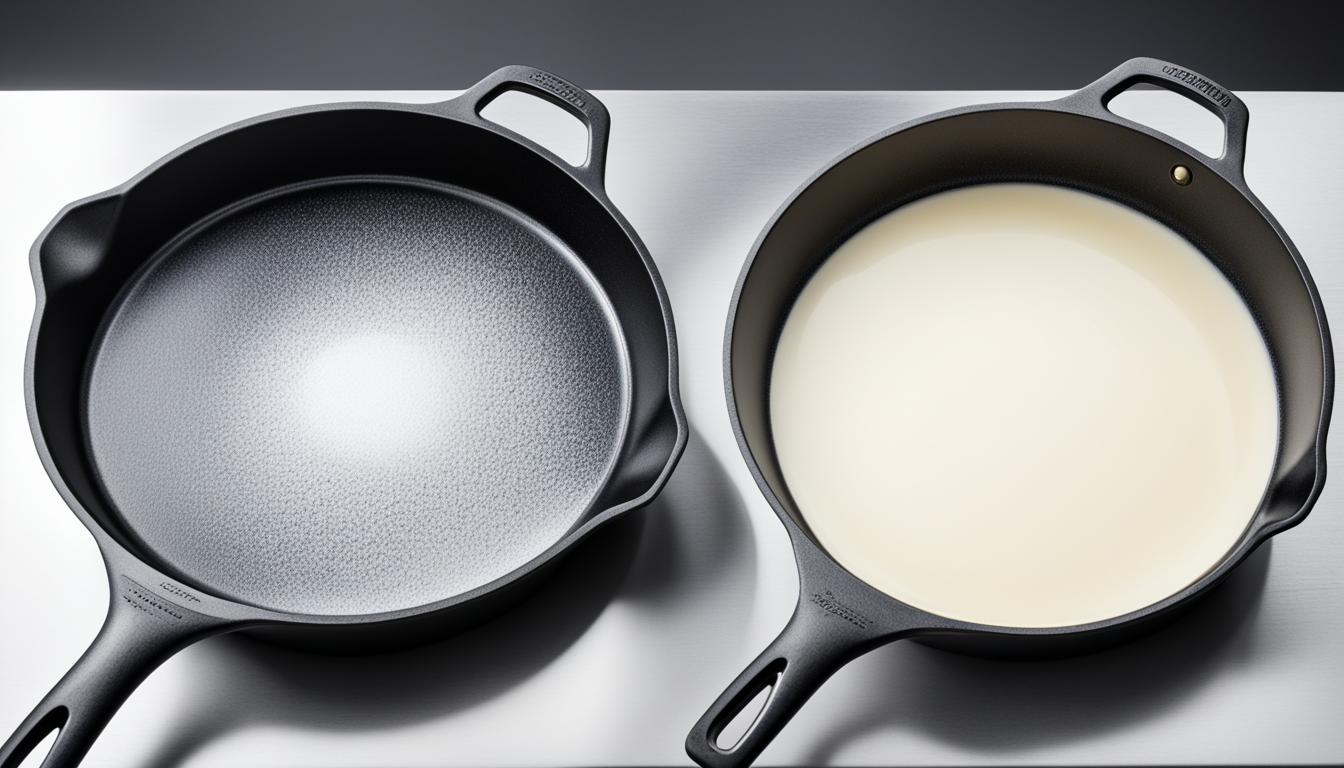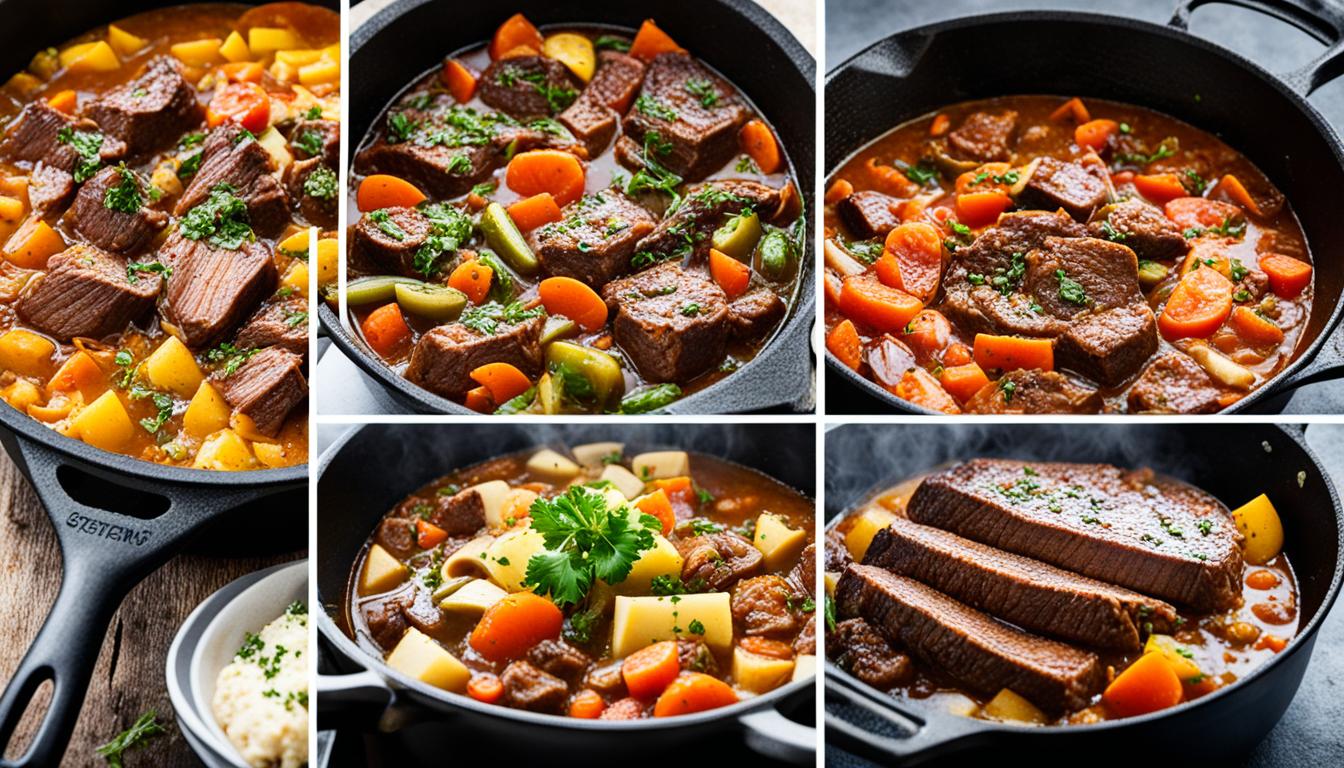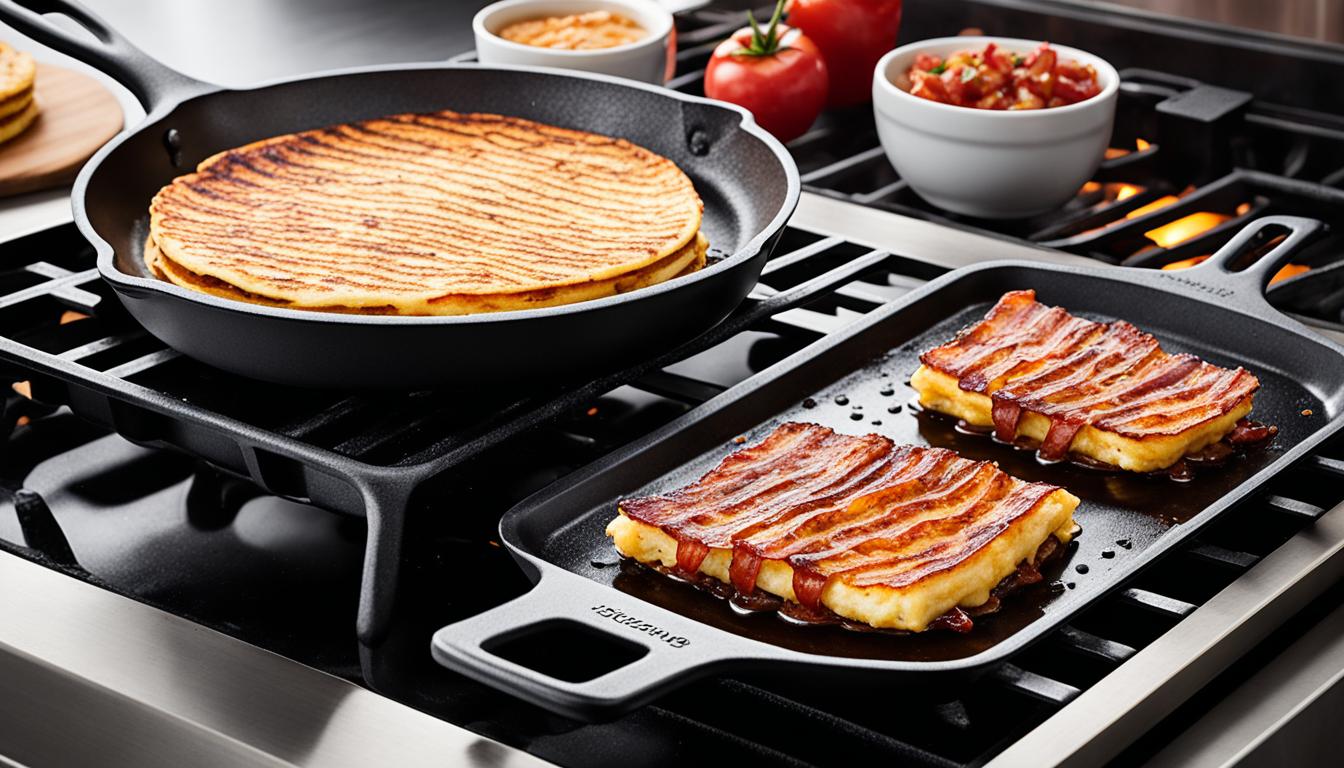Have you ever wondered why cast iron skillets are so beloved in kitchens across America? They have been a key kitchen tool for years. From searing steaks to baking cornbread, they do it all. Let’s look into what makes cast iron a favorite for anyone who cooks at home.
Cast iron skillets are like the Swiss Army knives in the kitchen. They work well for anyone, whether you’re just starting out or an expert. I’ve used mine for making Chicago-style deep dish pizzas and healthy beef and broccoli stir-fries. You can do so much with them!
What’s so great about cast iron is how it holds and spreads heat. This helps you get a perfect sear on your steak or a crispy crust on cornbread. Keep them well, and these pans can be with you for a lifetime. It’s a smart buy for your kitchen.
Key Takeaways
- Cast iron skillets are versatile cooking tools suitable for various cooking methods
- They can be used on any cooktop, grill, or open campfire
- Cast iron cookware is ideal for searing, roasting, baking, and frying
- These skillets are perfect for both beginners and experienced cooks
- With proper care, cast iron skillets can last for generations
Table of Contents
- 1 The Versatility of Cast Iron Cookware
- 2 What Is a Cast Iron Skillet Used For: Everyday Cooking
- 3 Searing and Browning Meats to Perfection
- 4 Frying and Deep-Frying Dishes
- 5 Baking Delicious Cornbread and Desserts
- 6 Roasting Vegetables and Whole Chickens
- 7 Seasoning and Maintaining Your Cast Iron Skillet
- 8 Foods to Avoid Cooking in Cast Iron
- 9 From Kitchen to Campfire: Outdoor Cooking with Cast Iron
The Versatility of Cast Iron Cookware
Cast iron skillets are essential in the kitchen. They are great for many cooking methods, making them vital for home cooks. This tool is tough and perfect for everything, like searing steaks and baking cornbread.
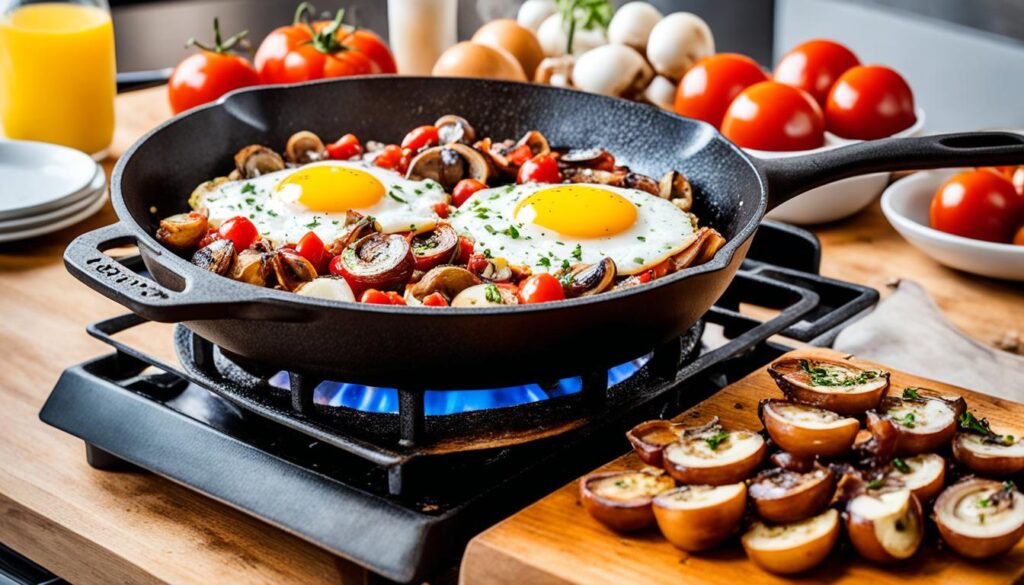
Cast iron cookware can do a lot. These are several common uses for my skillet:
- Stovetop cooking
- Oven baking
- Campfire cooking
- Grilling
- Broiling
One top dish I make is a Chinese Chicken Cabbage Stir Fry in my cast iron skillet. It’s quick, tasty, and shows off the skillet’s heat-handling skills.
Now, We will look at what makes cast iron cookware so good:
| Benefit | Description |
|---|---|
| Even Heat Distribution | It spreads heat well, getting rid of cool spots |
| Durability | It can last a long time if taken care of |
| Versatility | Great for many cooking styles and heat sources |
| Natural Non-Stick Surface | Over time, it becomes naturally non-stick |
| Adds Iron to Food | Cooking in it boosts the iron in your meals |
One feature I adore is going easily from stove to oven with my skillet. It lets me cook a whole meal in one pan, from the stove to the oven. This is perfect for dishes like skillet lasagna or deep-dish pizza.
Cooking with cast iron lets you do a lot in the kitchen. It’s great for searing meat just right and baking cornbread with a crispy edge. This tool is always ready to amaze in the kitchen.
What Is a Cast Iron Skillet Used For: Everyday Cooking
Cast iron skillets are amazing for daily meals. They’re perfect for both simple dishes and fancy recipes. Their heat retention helps in different cooking methods.
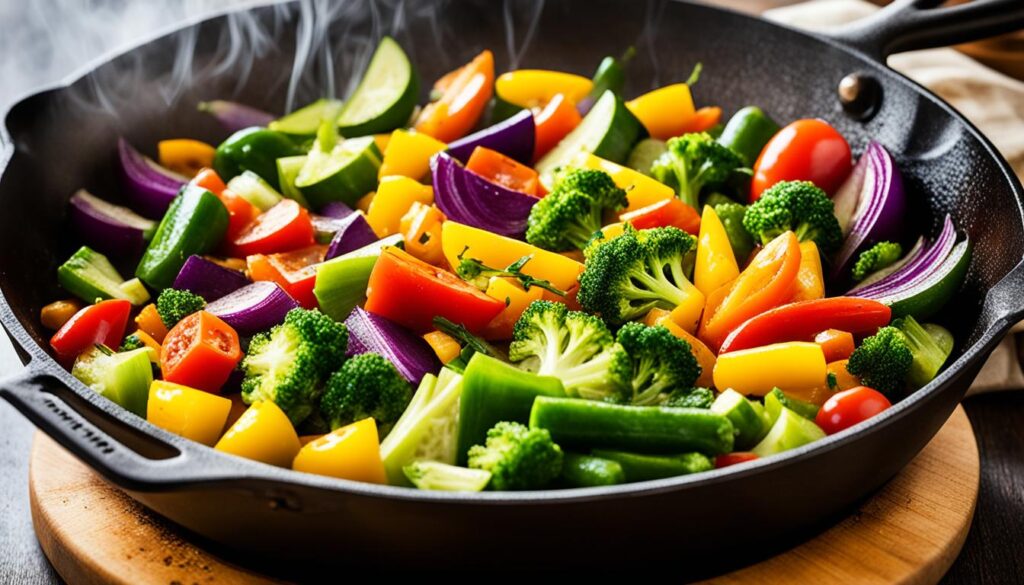
Frying Eggs and Bacon
Starting my day with fried eggs and bacon is a joy. A well-seasoned skillet makes them just right. It evenly cooks my eggs and gives the bacon a tasty crunch.
One-Pan Meals and Skillet Dinners
On busy nights, I love one-pan meals. For instance, a shrimp and dumpling stir-fry takes only 25 minutes and is so delicious.
This is how you make it:
- Prep time: 25 minutes
- Cooking time: 30 minutes
- Servings: 4
- Calories per serving: 327
The stir-fry mixes shrimp and dumplings in a special way. Anyone can change the veggies and proteins to their liking.
From Stovetop to Oven: Versatile Cooking Methods
Cooking with cast iron is so flexible. You can start on the stove and move to the oven easily. It’s great for recipes that need both fast and slow cooking.
Cast iron can handle a wide range of temperatures. This makes it great for almost any dish, like steaks or skillet cookies. Each time, it gives me amazing food.
| Cooking Method | Temperature Range | Ideal Dishes |
|---|---|---|
| Stovetop Searing | 400°F – 460°F | Steaks, Chicken Breasts |
| Oven Roasting | 350°F – 400°F | Whole Chickens, Vegetables |
| Baking | 325°F – 375°F | Cornbread, Skillet Cookies |
| Low and Slow Cooking | 200°F – 300°F | Stews, Braises |
My cast iron skillet is a go-to in the kitchen. It’s perfect for everything from quick meals to fancy dinners. It always makes my food taste great.
Searing and Browning Meats to Perfection
Cast iron skillets are perfect for getting a great crust on meats. Skillets hold heat really well. This is key for browning meats just right to keep them juicy.
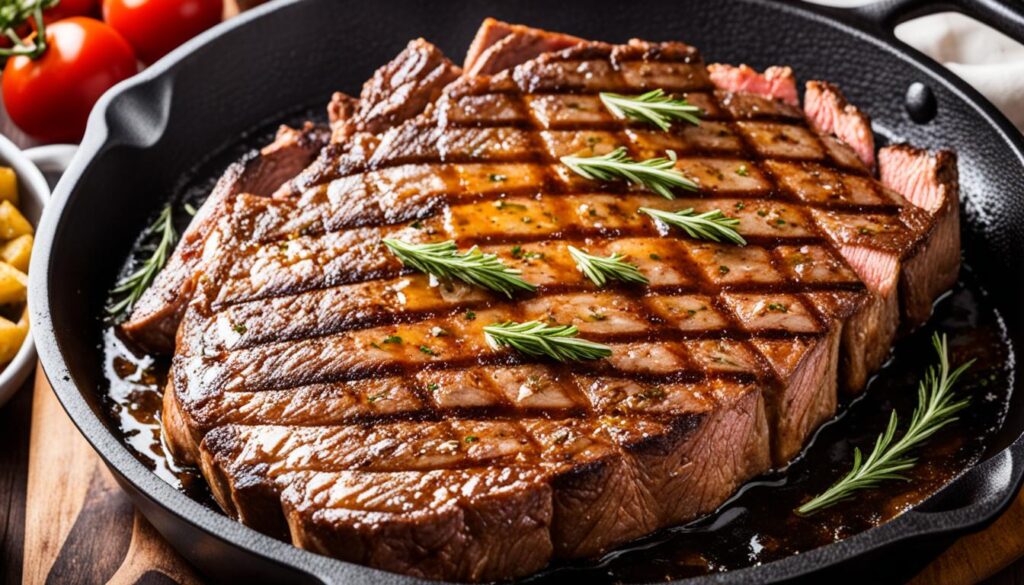
Achieving the Perfect Crust on Steaks
For a restaurant-style sear on steaks, follow these steps:
- Pat the steak dry with paper towels
- Preheat the skillet until it’s smoking hot (about 400°F)
- Add a thin layer of oil with a high smoke point
- Place the steak in the pan and don’t move it for 3-4 minutes
- Flip once and cook for another 3-4 minutes for medium-rare
The Maillard reaction is the magic here. This process at around 285°F gives deep flavors and the perfect brown crust.
Searing Chicken for Juicy Results
I start with bone-in, skin-on chicken for the best sear. The method is much like steak searing, but a bit different:
- Start with a cold pan to render fat from the skin
- Gradually increase heat to medium-high
- Cook skin-side down until golden brown (about 8-10 minutes)
- Flip and finish cooking in a 375°F oven
This method keeps the chicken moist with crispy skin. It works wonders for other meats too, like duck breasts.
Tips for Even Browning
I’ve picked up a few tricks for even searing:
| Tip | Reason |
|---|---|
| Don’t overcrowd the pan | It helps the meat cook evenly |
| Meat should be at room temp | It makes for more even cooking |
| Flip with tongs | This keeps the pan hot |
| Let meat rest | It keeps the meat juicy |
Being patient while searing is crucial. Don’t flip too soon; the meat will tell you when it’s ready. For cleaning tips, see this guide on cleaning cast iron skillets.
Frying and Deep-Frying Dishes
Cast iron skillets are great for frying and deep-frying. They’re perfect for making foods crispy and golden. The key is that they keep oil at the right temperature.
A deep cast iron pot is good for deep-frying. It stops oil from splattering. The best oil temperature is 350-375°F (175-190°C). Use a thermometer to check the temperature.
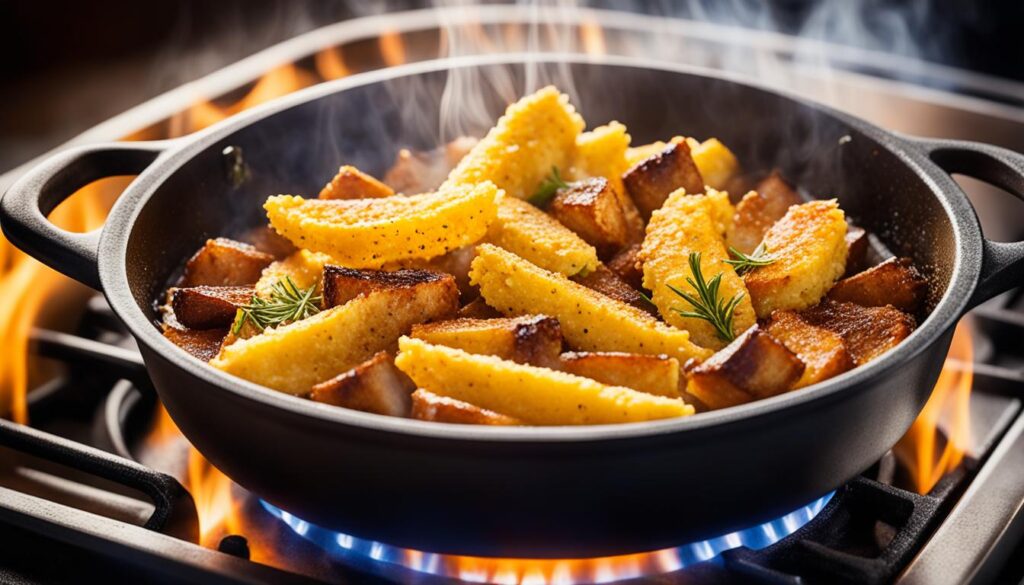
- Canola oil
- Vegetable oil
- Peanut oil
- Safflower oil
- Sunflower oil
To get the best results, do these steps:
- Put 1-2 inches of oil in the skillet for small foods. For big items like chicken, use up to 4 inches.
- Heat the oil to the right temperature.
- Coat the food in breading or batter to make it crispy.
- Use tongs or a slotted spoon to put the food gently in the oil.
- Fry until it’s golden and crunchy, and check if it’s cooked inside.
- Take the food out and let the extra oil drip off on paper towels or a rack.
After frying, cool and strain the oil. Store it for later uses. Always remember to get rid of the used oil the right way. Never pour it in the sink!
With these hints, you’ll soon be a pro at deep-frying in your skillet. Enjoy serving up delicious, crispy dishes that everyone will love!
Baking Delicious Cornbread and Desserts
I adore my cast iron skillet for baking. It helps me make lip-smacking cornbread and sweet skillet desserts. Baking in it lets me create all kinds of flavors.
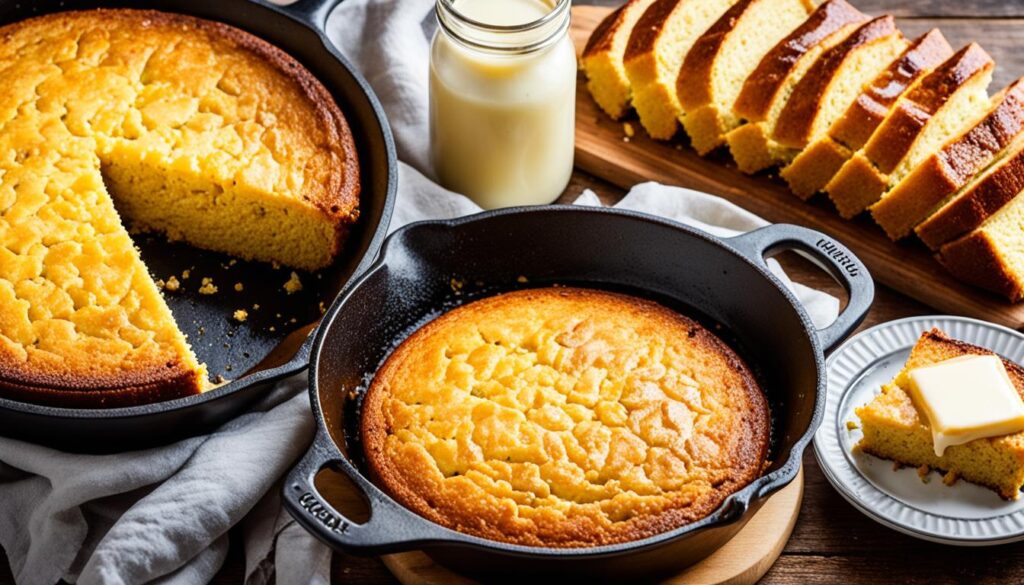
The Secret to Crispy Cornbread Crust
To get a perfect crust on my cornbread, I preheat my skillet in the oven. Set it at 450°F. This method gives the cornbread a crisp outside and a soft inside. Here’s what I do:
- 1½ cups cornmeal
- ½ cup all-purpose flour (or 1:1 gluten-free flour blend)
- 2 teaspoons baking powder
- 1 teaspoon salt
- ½ teaspoon baking soda
- 2 eggs
- 1½ cups buttermilk
- ¼ cup bacon fat (melted in the skillet)
Mix the dry ingredients, then add the wet ones. Be gentle to avoid over-mixing. Pour the batter into the hot skillet. Bake for 25-30 minutes. You’ll get a delicious cornbread. It’s crispy outside, soft inside. Serves 8, with 373 calories per slice.
Skillet Cookies and Other Sweet Treats
But my sweet treats don’t end with cornbread. I also enjoy making large cookies, cobblers, and brownies in my skillet. The even heat makes perfect crispy cookies with a soft middle. For cobblers, the skillet keeps them warm for a long time.
Balancing Sweet and Savory Uses
When I cook both kinds of dishes, I clean the skillet well. This avoids taste mixing. It makes my skillet great for all recipes, from cornbread to cookies.
| Dish | Baking Time | Temperature | Key Tip |
|---|---|---|---|
| Southern Cornbread | 25-30 minutes | 450°F | Preheat skillet for crispy crust |
| Skillet Cookie | 20-25 minutes | 350°F | Underbake slightly for gooey center |
| Fruit Cobbler | 35-40 minutes | 375°F | Add butter to skillet before fruit for caramelization |
Roasting Vegetables and Whole Chickens
Casting iron is my top choice for roasting veggies and birds. It makes every meal scrumptious and simple. The heat spreads evenly, making everything cook just right. You get sweet veggies and tasty chicken every time.
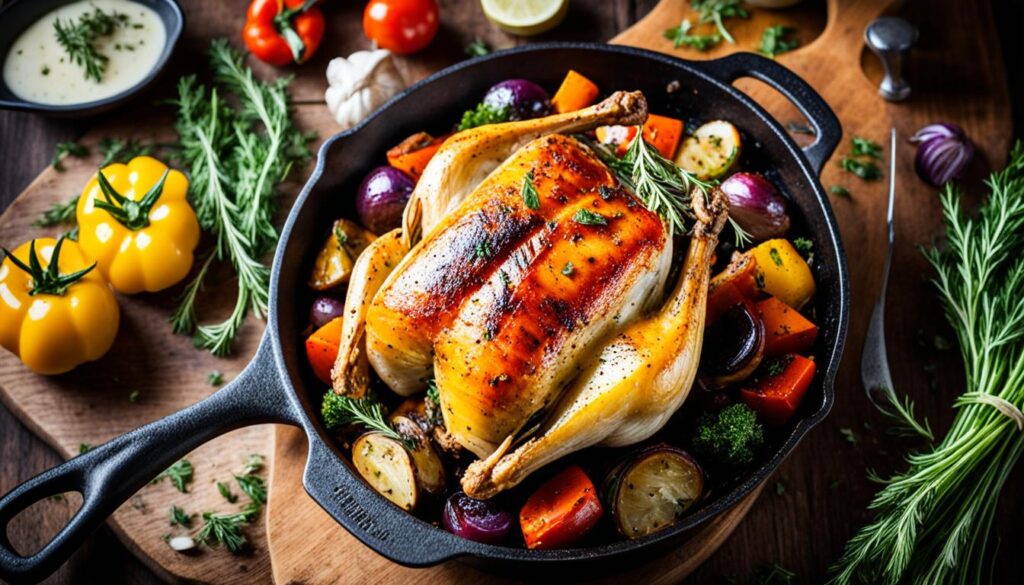
I want to share an amazing recipe from Thomas Keller’s book, Ad Hoc at Home. It highlights how great cast iron is for cooking. You’ll make a beautiful mix of vegetables and a flawless roasted chicken.
Ingredients for Skillet Roasted Chicken and Vegetables
- 1 (3-4 lb) kosher chicken
- 2 cups mixed root vegetables (rutabagas, turnips, carrots)
- 1 cup small red-skinned new potatoes, quartered
- 1 medium onion, cut into wedges
- 4 garlic cloves, peeled
- 2 tablespoons olive oil
- 2 sprigs fresh thyme
- Kosher salt and freshly ground black pepper
Step-by-Step Instructions
- Preheat your oven to 475°F.
- Pat the chicken dry and season it well, inside and out.
- Truss the chicken and put it in the skillet.
- Toss your veggies in oil, salt, and pepper. Place them around the chicken.
- Roast for 25 minutes, then lower heat to 400°F.
- Roast another 45 minutes, or until the chicken hits 165°F in the thigh.
- Rest the chicken for 20 minutes before serving.
Skillet roasting is a beautiful way to cook a meal. The veggies and chicken mix their flavors, creating a delightful taste. Using a cast iron skillet means the skin gets crispy and the veggies turn caramelized. This turns an ordinary dish into something stunning.
| Ingredient | Purpose |
|---|---|
| Kosher chicken | Provides optimal flavor and tenderness |
| Root vegetables | Adds variety and nutrition to the dish |
| Red potatoes | Retains moisture and adds heartiness |
| Olive oil | Promotes even browning and adds richness |
| Thyme | Infuses aromatic flavor throughout the dish |
For an even crispier chicken skin, leave it uncovered in the fridge for 1-2 days. This cooking method turns simple items into a fabulous meal. It’s great for family dinners or when friends come over.
Seasoning and Maintaining Your Cast Iron Skillet
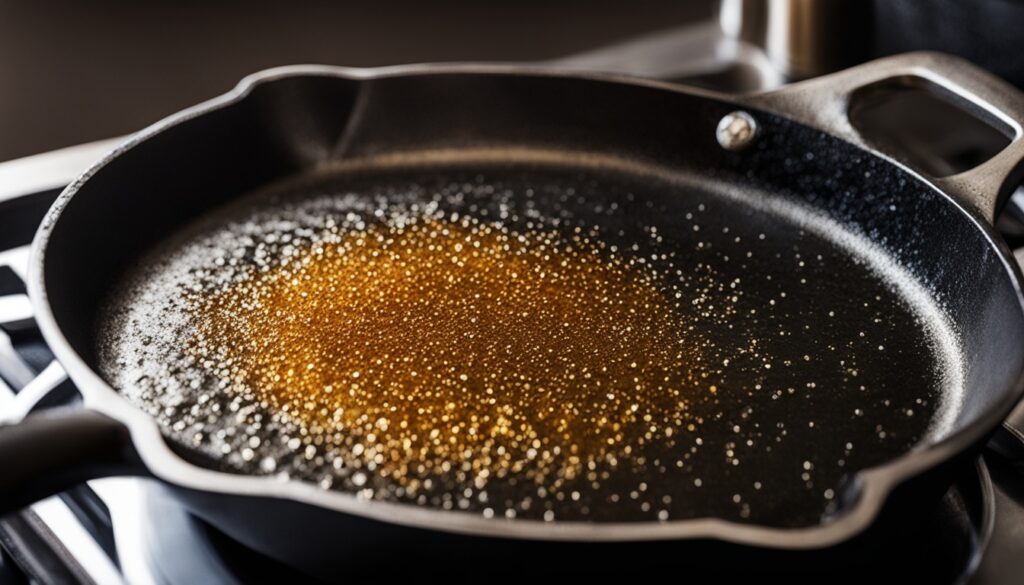
Seasoning your skillet is vital for a non-stick surface. It involves baking oil layers onto the skillet. This process safeguards the metal and boosts its cooking ability.
Here is how to season your skillet:
- Clean the skillet thoroughly
- Dry it completely
- Apply a thin layer of neutral oil (like canola or vegetable oil)
- Bake the skillet upside down in a 450°F oven for 1 hour
- Let it cool in the oven
But, seasoning alone won’t keep your skillet perfect. You must maintain it well. After use, clean the skillet while it’s warm. Avoid cleaning with tough detergents or metal scrubbers as they harm the seasoning. Instead, use hot water with a soft brush or sponge.
Here’s what to do for stuck-on food:
- Sprinkle coarse salt on the skillet
- Scrub with a cloth or paper towel
- Rinse with hot water
- Dry thoroughly
To keep rust away and the surface non-stick, apply a thin oil layer after each clean. Heat the skillet until it’s dry, then wipe with a little oil. This is key for maintaining your seasoning.
Lastly, using your skillet often improves its seasoning. Cooking fatty foods helps develop a better non-stick layer. With good care, your cast iron skillet will last for many years.
Foods to Avoid Cooking in Cast Iron
Cast iron skillets are great for most cooking. But, some foods can harm the skillet and meal. We’ll look at what not to cook and why, to keep your cast iron working well.
Acidic Foods and Tomato-Based Sauces
Acidic items can wear off the skillet’s seasoning. So, skip cooking these in cast iron:
- Tomato sauces
- Citrus-based marinades
- Wine-heavy dishes
- Vinegar-based recipes
Your meal might taste like metal if you use iron with acidic foods. Use electric skillets with removable pans for these dishes. They’re better suited.
Delicate Fish and Sticky Foods
Some foods just don’t work well in cast iron because of their textures:
- Flaky fish fillets
- Eggs (especially in a not well-seasoned skillet)
- Pancakes and crepes
- Sticky sauces or caramel
These foods can stick and mess up. Even a well-seasoned skillet struggles with them.
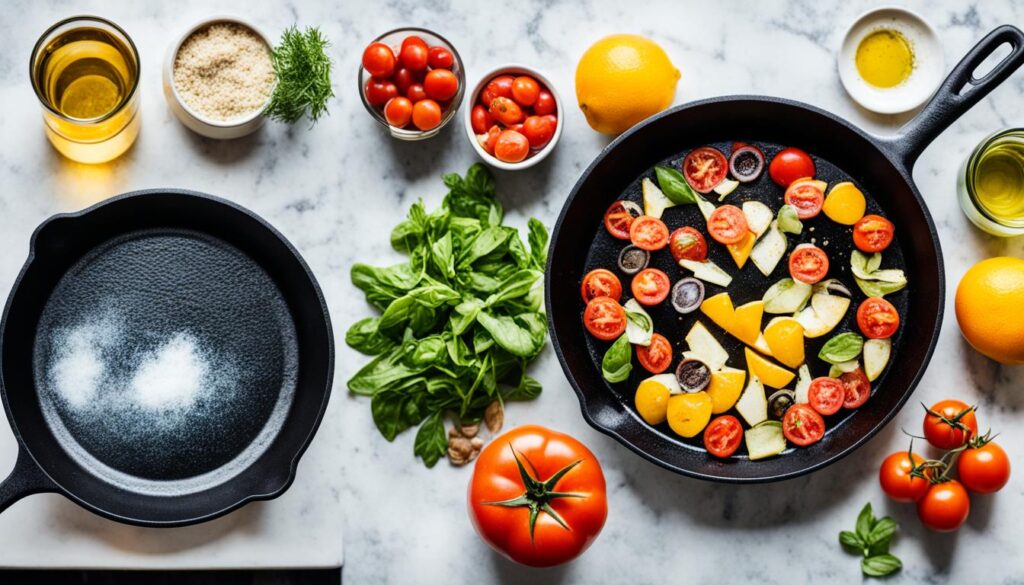
Preventing Flavor Transfer in Your Skillet
Cast iron can pick up flavors, good or bad. To avoid mixing tastes:
- Clean thoroughly after each meal
- Don’t cook strong-flavored foods just before delicate ones
- Re-season your skillet often
Knowing these limitations guides me in cooking smarter. This way, I protect my skillet and boost my cooking game.
| Food Type | Potential Issue | Alternative Cookware |
|---|---|---|
| Acidic Foods | Strips seasoning, metallic taste | Stainless steel or ceramic |
| Delicate Fish | Sticking, falling apart | Non-stick pan |
| Sticky Foods | Difficult cleanup | Enamel-coated cast iron |
| Strong-flavored Foods | Flavor transfer | Dedicated cast iron for specific flavors |
From Kitchen to Campfire: Outdoor Cooking with Cast Iron
Cast iron skillets are perfect for cooking over a campfire. They hold heat well and add a special flavor. I love using mine to make everything from breakfast eggs to comforting stews. It’s reliable for all my outdoor meals.
To make the most of campfire cooking, starting the fire early is key. This lets the wood turn into even, hot coals – the best for cooking. I follow the advice of many and opt for dried oak wood. It’s better than hickory or mesquite, which can make your food taste bitter.
One of my favorite outdoor cooking activities is a Dutch oven cook-off. It’s a neat tradition where families make and share meals in their Dutch ovens. We then choose our favorite. This adds a fun challenge to our camping and helps me learn new cooking tricks.
Safety should always come first when cooking outside. I use a digital thermometer to make sure meats are cooked through. With a few simple rules and a reliable cast iron skillet, outdoor meals can be both safe and scrumptious.
